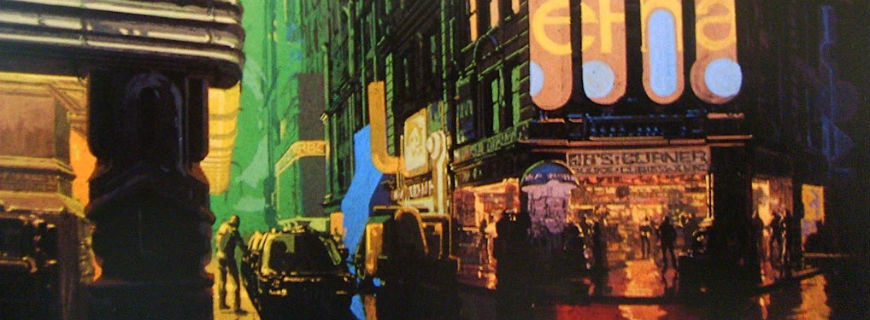Space Oddities: Visual Futurist

Space Oddities: Visual Futurist: The Art & Life of Syd Mead (Joaquin Montalvan,2006)
Each month, Raz Greenberg reviews an overlooked piece of science fiction, fantasy or horror – be it a film, a television episode, a comic or a game – one that should have gotten more attention when it first came out and should still be remembered, in his opinion. This month, he reviews a documentary film about one of the greatest designers of science fiction cinema..
“At a meeting, as I brought my first sketches to John (Dykstra), for him to look at, and later to show to (Robert) Wise, I guess, and he said ‘What is it?’, and I said ‘Well, John, it’s a three-dimensional, multiple-access entity that rotates on its own central axis’. And he said ‘Whatever’.”
-Syd Mead, describing his debut film work on “Star Trek: The Motion Picture”
Yes, this month’s review is about a documentary film, devoted to one of the most important designers of futuristic scenery in the history of cinema, and a man who shaped much of the imagery associated with modern geek culture. The designer in question is Syd Mead. The film is Visual Futurist: The Art & Life of Syd Mead.
It should be noted the film, directed by Joaquin Montalvan, was produced by Mead’s own company, so those looking for a critical look at Mead’s work won’t find it here. What they will find, however, is a fascinating, detailed overview of Mead’s career, from his youth as a car-loving boy through his days as an industrial designer for motor-companies to his big film and real-world projects, up to the late 1980s. It also gives viewers a chance to understand just what makes Mead so successful at what he does.
Beauty and the Functionality
Mead’s works came to the attention of the wide audience (among genre fans, at least) following his work on Ridley Scott’s Blade Runner, a film which made him a brand name in science fiction design just as Scott’s Alien did to Swiss artist H.R. Giger three years earlier. But while Giger made a name for himself due to his nightmarish portrayals of flesh and technology that drew inspiration from the gothic European tradition, Mead’s futuristic dreams are highly optimistic, a product of the American Fordism (literally – he worked as a designer for the Ford Company). Though he designed some of the most beautiful props in the history of science fiction cinema, visual appeal never appears to be high in Mead’s priorities when he describes the work on his many projects: the question “how does it work?” poses far greater interest for him, as demonstrated in the above quote. The beauty of Mead’s designs is a byproduct of their functionality.
Visual Futurist opens with Mead recalling and recounting experiences from his early life and education, as stills of photographs and illustrations appear on the screen. Less than ten minutes into the feature, it scores its first memorable moment when Mead describes the excitement and fear of driving on a highway for the first time: his narration is heard while an illustration of the futuristic Los Angeles appears on the screen. Such a subtle link between Mead’s biography and the nature of his work gives viewers a true insight to his personal and artistic growth. Short interview segments with Mead himself and his colleagues are also featured, setting the tone for the rest of the film: alternating between the presentation of stills, accompanied by Mead’s narration, and interviews.
Blade Runner
In-depth discussion of Mead’s film-work starts about 30 minutes into the film. There are no film clips, and relevant Mead designs are presented through his illustrations. I assume that it was done for budgetary reasons (and the logical assumption that whoever will watch this documentary will also be familiar with most the works discussed in it). The films discussed most extensively are naturally Mead’s two big projects, Blade Runner and Tron. Blade Runner fans will be delighted to hear Mead’s explanations of the rationale behind the designs of the flying Spinner cars and the Voight-Kampff machine. Other interviewees include film producers Michael Deeley and Katherine Haber, journalist Paul M. Sammon, and vehicle-builder Gene Winfield (who provides some interesting facts about the difficulties in the transition from Mead’s illustrations to physical models). Director Ridley Scott, however (and again, I assume that has something to do with budget issues), is not interviewed in the film and his absence is unfortunate. Still, Blade Runner fans will find a lot to like here, and Visual Futurist makes a great supplement for another excellent documentary film, Dangerous Days as well as to Sammon’s book Future Noir.
Tron
Then there is a discussion of Tron. Both director Steve Lisberger and special-effects supervisor Richard Taylor are interviewed, and their perspective on producing a film that takes place inside a video game long before Hollywood went digital is interesting, though its relevance to Mead’s work seems somewhat off. Lisberger also details his surprisingly-deep ideas about the meaning behind the film as a metaphor for oppression, and this is where Mead’s designs, with their intimidating cubic look make their big impression, from the film’s environment to its logo. Along with Mead’s own explanations about the work done on the film, watching Visual Futurist made me appreciate the work done on Tron as a creative experiment, if not as a finished product.
Other film projects are discussed more briefly, but then again, Mead’s involvement in them wasn’t as extensive as it was in either Blade Runner or Tron. One particularly charming design story told by Mead is how he researched the Japanese robotics industry for inspiration when he worked on the film Short Circuit. The stories behind other props are also interesting, but since these props came mainly from sequels or existing franchises, I felt that some comments on the context could have been useful. For example, Mead goes into detail about his spaceship designs for both 2010 and Aliens, and beautiful illustrations that demonstrate the development of these ships are shown, but the fact that each of these films was a sequel to previous films that were considered visual masterpieces is not even mentioned – nor, strangely enough, the huge impact that Mead’s work on these spaceships had on the design of later genre productions (a notable example being the television show Babylon 5). The same is true for Mead’s work on the first Star Trek film, discussed without even touching the franchise’s huge cultural influence, or his works on Japanese animation franchises such as Space Battleship Yamato and Mobile Suit Gundam (the latter is not touched upon in Visual Futurist) – having mead working on such franchises is the equivalent of having a Japanese designer hired to re-design the Enterprise or the Millennium Falcon.
Despite these shortcomings, Visual Futurist is well worth watching. For those who have always adored Mead’s works but had no idea that he’s behind them, it can serve as a great introduction to one of the greatest futuristic designers ever.
Where to get it
Visual Futurist: The Art & Life of Syd Mead has in the past been available through regular online retailers as Amazon, but this no longer appears to be the case. A copy can be bought from Mead’s official website.




